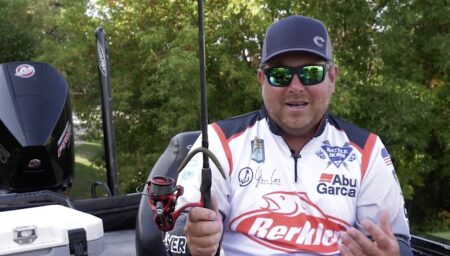When we walk through tackle stores or look at tackle online, there is no shortage of ice fishing jigs for panfish. Particularly for new or beginning anglers, the choices can be intimidating. When we talk panfish through the ice, namely crappie, bluegill, sunfish and even perch… we can really narrow the tackle selection process down to three basic categories: small spoons, horizontal jigs and vertical jigs to cover the gamut for most panfish on the ice.
We break down these three lure categories and highlight the strengths of each lure category. Most of the time, we focus on the lure category, size and profile with color being one of the final variables that is usually less important. In an industry designed to catch anglers, let’s cut to the chase.
Small Spoons

Spoons can be made from zinc, lead or some other type of metal. Spoons can either have a split ring and treble hook or a single hook that can be molded into the spoon. Spoons typically offer a larger profile and do displace more water and provide more flash compared to most other panfish jigs. This larger footprint can be seen from greater distances and the larger profile can also be used to sort out the larger fish in a school.
Spoons are a great search lure for panfish. Spoons can shine on aggressive bites or whenever fish are spread out over large featureless areas. Examples include crappies suspended out over massive basins or perch roaming large featureless flats. One reason that spoons can shine for breaking down large amounts of real estate is that the footprint of a spoon can be seen and felt from a little bit further away so the fish can also find you from greater distances. We have also seen spoons shine for pulling panfish up out of dense weed canopies and dense flooded timber or brush piles. For fishing through water fast and sampling a lot of water and simply breaking down water, spoons can be a great tool for finding panfish.
For panfish, we are often tipping spoons. Tipping options might include a few waxworms, several spikes or maggots. You can also tip spoons with a soft plastic. Usually, I prefer a swinging treble hook for tipping with waxworms, spikes, maggots. I prefer the single hook if the bite is extremely aggressive or when rigging plastics in conjunction with the spoon. I like to rig the plastic so it is positioned horizontal off the bottom of the spoon. Use the spoon to pull fish in and quiver the plastic when fish get on top of you.

Horizontal Jigs

Horizontal ie fishing jigs are just what they imply, a small panfish size jig that hangs horizontal in the water. Overall, horizontal jigs are probably the most popular and widely used presentation option for panfish. Horizontal jigs can be tipped with either live bait like wax worms, maggots or tipped with soft plastics.
As a rule of thumb, anglers might rely on the larger sizes for dropping down into deeper water, covering more water by fishing faster or targeting aggressive fish while the smaller sizes are used when conditions dictate like highly pressured water, smaller fish, less aggressive fish, tough bites, etc. Horizontal jigs have traditionally been made of lead but today, tungsten has become popular with ice anglers because tungsten is heavier than lead which increases sensitivity by enabling smaller profiles or fishing heavier by dropping through the water faster when attempting to get back down to fish and taking memory out of line. Horizontal jigs cover the spectrum as far as presentation in that you can fish larger sizes with bulked up soft plastic profiles to target big crappie or scale down to much smaller sizes tipped with a single maggot to finesse tough bluegill.
Vertical Jigs

Vertical ice fishing jigs include the classic tear drop jig styles and because of the eyelet placement, these jigs hang vertical in the water. Vertical jigs seem to shine on tougher bites. Because panfish are often looking up at the bait and rising to eat, vertical jigs create a much smaller profile to the fish. Because of the orientation, vertical jigs have a more subtle water displacement.
Vertical jigs are our go to whenever the bite gets really tough. Might be heavily pressured lakes, extremely clear water, middle of the winter doldrums, middle of the day, post cold front conditions. We find that when we struggle to get bit, finesse with vertical jigs can save the day. A vertical jig has about half the profile from a fish’s perspective as the same size horizontal jig. Vertical jigs don’t fall through the water as fast and aren’t as well suited for breaking down water fast but when you know right where fish are and are having a tough time getting fish to eat, that is the time for finesse with vertical jigs.

These three lure categories really cover the heavy lifting for big percentage of the ice fishing we do for panfish each winter. Of course, big crappie can be caught on lures like Ripping Raps. Swim lures like Tikka Minos catch big perch but day in and day out, these three lure categories will get you to the end zone. Remember as well that these three lure categories compliment each other. You might use small spoons to sample a lot of different spots quickly to look for activity. You might start out the day with horizontal jigs and soft plastics when the sun is low and then switch up to vertical jigs and wax worms during the middle of the day if the bite gets tougher. Keep each arrow in your quiver as you fish through each day and progress through the ice fishing season.




